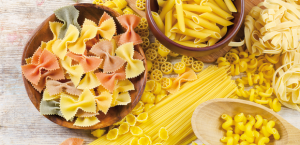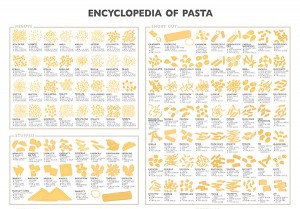Sapete cuocere la pasta?Do you know how to cook pasta?
Banale? Forse per noi Italiani, e non per tutti, dedichiamo quindi questo articolo agli amici stranieri che vogliono gustare un piatto di pasta fatto come Dio comanda.

1. A meno che non si tratti di tagliatelle fresche, che richiedono untegame largo e basso, cuocete la pasta sempre in pentole cilindriche e grandi, tenendo presente, al momento della scelta della pentola, che…
2. La proporzione acqua-pasta deve essere di un litro ogni 100 g di pasta.
3. Il sale va buttato nella pentola quando l’acqua comincia a fremere, circa tre minuti prima della pasta. La dose è di 10 g di sale grosso per ogni litro di acqua. Ricordate che la quantità di sale va sempre rapportata alla quantità di acqua e non alla quantità di pasta.
4. La pasta va buttata in un colpo solo quando l’acqua raggiunge il bollore pieno.
5. Prima di buttare la pasta, costituite una riserva di calore: quando l’acqua bolle abbassate la fiamma e portate l’acqua a bollore pieno con quella fiamma bassa. Quando buttate la pasta, alzate contemporaneamente la fiamma, che riporterà l’acqua a bollore pieno subito.
6. I tempi di cottura variano con la qualità del grano e col formato della pasta. I tempi riportati sulle confezioni sono generalmente attendibili per la pasta fabbricata in Italia, assolutamente non lo sono per la pasta di provenienza estera.
7. La pasta fresca all’uovo, per esempio le tagliatelle, deve cuocere pochi minuti, da 2 a 4, da quando viene a galla. Il tempo esatto dipende dallo spessore che è variabile.
8. I tempi di cottura della pasta fresca non all’uovo, per esempio delle orecchiette eccetera, sono intermedi fra quelli della pasta all’uovo e della pasta secca, cioè 6 minuti circa.
9. Girate spesso la pasta e assaggiatela. Solo così, a parte tutto, giudicherete la giusta cottura.
10. Non fermate mai la cottura della pasta con l’acqua fredda. Invece scolatela velocemente, conditela e servitela con altrettanta velocità. Non c’è niente di più deludente di un piatto di pasta “riposata”.
 Trivial? Maybe for us Italians, and not for everyone, so we dedicate this article to the foreign friends who want to enjoy a plate of pasta made as God intended.
Trivial? Maybe for us Italians, and not for everyone, so we dedicate this article to the foreign friends who want to enjoy a plate of pasta made as God intended.

1. Unless it is fresh tagliatelle, which require a wide, flat pan, cook the pasta always in cylindrical and large pots, bearing in mind, at the time of the choice of the pot, which …
2. The proportion of water-pasta must be of a liter per 100 g of pasta.
3. The salt should be thrown into the pot when the water begins to quiver, about three minutes before the pasta. The dose is 10 g of salt per liter of water. Remember that the amount of salt should always be compared to the amount of water and not to the quantity of pasta.
4. The paste should be thrown at once when the water reaches full boil.
5. Before you toss the pasta, formed a reservoir of heat: when the water boils reduce the heat and bring the water to a full boil with the low heat. When toss the pasta, turn up the heat at the same time, which will bring the water to a full boil immediatly.
6. The cooking times will vary with the quality of the grain and with the shape of the pasta. The times given on the packaging are generally reliable for Italian manufactured pasta, absolutely not for the pasta from abroad.
7. The fresh egg pasta, for example tagliatelle, must cook a few minutes, from 2 to 4, from when it is afloat. The exact time depends on the thickness that is variable.
8. The cooking times of the pasta without egg, for example, the orecchiette, etc., are intermediate between those of egg pasta and dry pasta, that is, about 6 minutes.
9. Turn the pasta and taste it often. Only in this way, apart from everything, you judge proper cooking.
10. Do not ever stop cooking pasta with cold water. Instead drain quickly, season and serve with equal speed. There is nothing more disappointing than a plate of pasta “rested”.






Leave a comment